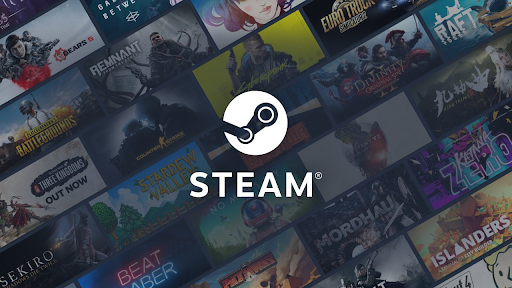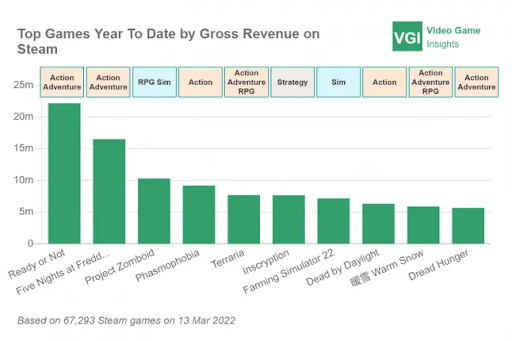The Ultimate Guide To Make Money On Steam
Beyond being a mere gaming platform—Steam has become a virtual marketplace teeming with economic opportunities for savvy gamers and entrepreneurs.
– 19 mins

Steam has an impressive user base of over 120 million active players and is estimated to generate a revenue of $8.856 billion in 2024. This digital gaming platform developed by Valve Corporation, not only facilitates the purchase and play of video games but has also cultivated a thriving marketplace for in-game items, digital assets, and user-generated content.
The economic potential on Steam extends beyond gaming enthusiasts to developers, modders, and even traders. There were more than 50,000 games on the platform, and as per a report, Steam is estimated to sell over 400 million games in 2023. Moreover, Steam Workshop—a hub for user-generated content, has seen millions of submissions, creating a vibrant marketplace for creators to monetize their skills.
In this comprehensive guide, we will walk you through the opportunities that Steam presents, offering insights into how you can leverage your passion for gaming into a lucrative venture. From game development and trading to the world of virtual items and beyond, prepare to unlock the secrets and make money on Steam.
Is it possible to make money on Steam?
Making money on Steam is a viable prospect, primarily revolving around game development, virtual items, and user-generated content.
First and foremost—developers can monetize their creations by selling games on the platform. Steam serves as a massive marketplace for digital game distribution, allowing developers to reach a global audience. While Steam takes a percentage of each sale, successful games can yield substantial revenue, fostering a lucrative avenue for game developers.
Moreover, in-game items and microtransactions contribute significantly to revenue generation. Many games on Steam incorporate virtual items, skins, or additional features that players can purchase. This enhances the gaming experience and provides developers with an ongoing revenue stream. The Steam Workshop further extends this opportunity by enabling users to create and sell mods or additional content for existing games, fostering a dynamic user-generated content ecosystem.
‘Steam Trading Cards’ and the ‘Steam Community Market’ offer an alternative means of making money. Players can earn virtual trading cards by playing games, and these cards can be sold, traded, or crafted into game-related items. This unique system creates a marketplace within Steam, allowing users to monetize their gaming activities. Additionally, through features like Steam Broadcasting, the platform’s support for content creators enables gamers to earn money by streaming their gameplay or creating content related to Steam games.
Steam offers a multifaceted landscape for individuals to make money through game development, in-game transactions, user-generated content, and content creation. Success in these endeavors often hinges on factors such as the quality of the product, effective marketing strategies, and community engagement.
How to make money on Steam?
Making money on Steam is dynamic—presenting diverse avenues for developers and gamers. The platform offers lucrative opportunities, from game sales and in-game transactions to user-generated content. Steam attracts millions of users as a global digital distribution giant, creating a thriving marketplace.
Here are the key strategies and avenues to harness the financial potential of Steam—whether you’re a game developer, content creator, or an avid gamer looking to monetize your gaming experience.
1. Publish a complimentary blog
Starting a complimentary blog on Steam provides a versatile platform to combine your passion for gaming with various monetization strategies. By consistently delivering valuable content, building a loyal readership, and exploring diverse revenue streams, you can turn your blog into a sustainable source of income while contributing to the vibrant gaming community on Steam.
A blog provides a platform to share insights, reviews, and content related to Steam games, fostering a community and attracting a dedicated audience.
Here are the details of how this model works!
Game reviews and affiliate marketing
Initiate your blog by crafting in-depth and insightful game reviews. As your readership grows, you can leverage affiliate marketing by incorporating affiliate links within your reviews. When users click on these links and make purchases on Steam through your referral, you earn a commission. Choose games that align with your audience’s interests and provide honest and valuable reviews to build trust and leverage them for your business.
Sponsored content and partnerships
As your blog gains credibility and a substantial following, developers or gaming-related brands may approach you for sponsored content opportunities. This can include writing posts, creating videos, or featuring specific games on your blog. Sponsored content and partnerships can become a reliable source of income, especially if your blog caters to a niche audience with specific interests.
Ad Revenue
Implementing display advertisements on your blog can generate revenue through ad impressions and clicks. Platforms like Google AdSense can be integrated into your blog, showcasing relevant ads to your audience. It is crucial that the ads complement your content and don’t compromise the user experience. Over time, when you drive crazy traffic on your blog, ad revenue can contribute significantly to your overall income.
Merchandising and affiliate sales
Create branded merchandise related to your blog or gaming content, such as t-shirts, mugs, or stickers. Promote and sell these items on your blog, and consider integrating affiliate sales for gaming-related products. You receive a commission when your audience purchases items through your affiliate links. This strategy not only adds a personal touch to your brand but also diversifies your revenue streams.
Exclusive content and memberships
Offer exclusive content or membership programs to your readers who subscribe or become members of your blog. This could include premium articles, early access to reviews, or members-only giveaways. Charge a subscription fee or offer tiered memberships with different benefits. Creating a sense of exclusivity can incentivize your audience to support your blog financially.
2. Sell in-game items and microtransactions
Making money on Steam through in-game items and microtransactions has become a significant and sustainable avenue for developers but requires a strategic and player-centric approach.
Here’s a detailed exploration of how this model works!
Virtual items and skins
One of the primary ways to generate revenue on Steam is by introducing virtual items and skins within games. These items can range from cosmetic enhancements to functional upgrades, allowing players to personalize their gaming experience.
Creating desirable content
The success of in-game items and microtransactions hinges on the appeal of the content offered. Developers must create high-quality, visually striking, or unique items that resonate with the player base. The more desirable the items, the higher the likelihood that players will be willing to spend money on them.
Limited edition or rare items
Introducing limited edition or rare items adds an element of exclusivity, encouraging players to make purchases to acquire these special in-game assets. The scarcity of these items enhances their perceived value, creating a sense of urgency among players to participate in the microtransactions.
Regular content pudates
Developers should provide regular content updates to keep players engaged and interested in making microtransactions. This could include the introduction of new items, seasonal content, or themed collections.
Community engagement
Building a strong community around the game is crucial for the success of in-game items and microtransactions. Developers can leverage platforms like Steam forums to engage with players, seek feedback, and understand their preferences. A responsive and engaged community is more likely to participate in and support microtransactions.
Incentivizing purchases
Developers can implement various incentives to drive microtransactions, such as offering discounts on bulk purchases, providing exclusive items for a limited time, or incorporating a reward system for frequent buyers. These strategies encourage players to spend more within the in-game marketplace.
Events and limited-time offers
Hosting in-game events and limited-time offers creates a sense of urgency, prompting players to participate in microtransactions to take advantage of exclusive deals or rewards. These time-limited opportunities contribute to spikes in in-game purchases during specific periods.
Transparency and fairness
Maintaining transparency regarding the pricing and value of in-game items is essential. Players are more likely to engage in microtransactions if they perceive the pricing as fair and the items as providing genuine value to their gaming experience. Any perception of unfairness can lead to negative player reactions and impact the success of the in-game economy.

3. Game development and sales
Making money on Steam through game development and sales is a multifaceted process that involves creating a compelling game, marketing it effectively, and leveraging the platform’s extensive user base. Developers who navigate these elements successfully can establish a profitable presence on one of the world’s largest gaming platforms.
Here’s how it works on Steam!
Game development
The journey begins with the development of a high-quality and engaging game. Developers must invest time and resources in crafting a product that stands out in the competitive gaming industry.
Steam greenlight and early access
Steam provides opportunities for developers to showcase their games through programs like Steam Greenlight and Early Access“. Steam Greenlight allows the community to vote on games they would like to see available on the platform, providing valuable feedback and gauging interest. Early Access allows developers to release their games to the public in an unfinished state, garnering support, feedback, and funding while the game is still in development.
Effective marketing
Successful game development on Steam requires effective marketing strategies. As a developer, you must build anticipation and awareness through trailers, social media, and promotional materials. Engaging with gaming communities and influencers and utilizing platforms like Steam’s marketing tools are essential for maximizing visibility and driving sales.
Steam direct and revenue Share
Once your game is ready for release, you can publish it on Steam through the Steam Direct program. While there is an initial fee to publish a game on the platform, developers benefit from a revenue-sharing model. Steam typically takes a percentage of each sale, allowing developers to earn a significant portion of the revenue generated by their games.
Steam sales and promotions
Participating in Steam Sales and promotions, such as the summer or winter sale, can significantly boost sales. Discounts and special offers during these events attract a larger audience, creating a spike in purchases.

4. Steam trading cards and Steam market
Making money on Steam through Steam trading cards and the Steam market provides users with a unique and gamified way to earn income.
Here’s how it works:
Steam trading cards
Steam trading cards are virtual cards that players can earn by playing participating games on Steam. These cards feature game artwork and can be collected to complete sets. Players receive a portion of the total card drops, and completing a set allows them to craft a badge. Earning badges grants various benefits, such as profile enhancements and emoticons.
Card sales and trades
Players can sell or trade their extra cards on the Steam Market. These transactions occur between users, with prices determined by supply and demand. The rarity of certain cards and the popularity of specific games can influence their market value. Engaging in strategic trades or selling cards during peak demand periods can maximize profits for users.
Steam market transactions
The Steam market serves as a centralized platform for buying and selling various in-game items, including trading cards. Users can list their cards for sale at a specific price, and others can purchase them directly. Steam facilitates secure transactions, ensuring buyers receive the items they purchase and sellers receive the agreed-upon funds.
Crafting and badges
Players can craft badges using sets of trading cards. Crafting badges provides several benefits, including Steam profile customization, emoticons, and discounts on other Steam items. While crafting badges may not directly result in monetary gains, the associated rewards can enhance the gaming and community experience.
Booster packs and booster pack sales
Users can also receive random Booster Packs containing additional trading cards by participating in the Steam Trading Card system. Booster Packs are earned by players who have collected a full set of cards and can be opened to receive additional cards. Players can sell these booster Packs on the Steam Market, adding another dimension to their potential earnings.
Community market fees
It’s important to note that Steam charges fees for transactions on the Steam Market. Sellers pay a fee when their item is sold, and buyers may also encounter fees based on their region. Being aware of these fees is crucial for users aiming to optimize their profit.

5. Hold and sell pre-release content
Making money on Steam through holding and selling pre-release content involves strategic investment in games or virtual items before they are officially released to the public. It requires a keen understanding of the gaming market, trends, and the potential value of specific items or games.
Here’s how it works:
Understanding early access and pre-release content
Steam often offers the option for developers to release games in early access, allowing players to purchase and play games that are still in development. Additionally, some games release exclusive pre-release or beta content that can be acquired through various means. Recognizing the potential value and demand for such content is the first step in making money through this strategy.
Strategic purchases and investment
To hold and sell pre-release content, individuals need to strategically purchase items or games with the expectation that their value will increase over time. This could involve investing in limited edition versions of games, exclusive in-game items, or pre-release packages that offer unique content or perks.
Timing and market trends
The successful implementation of this strategy relies heavily on timing. Understanding market trends, upcoming game releases, and the potential for certain items to appreciate in value is crucial. Awareness of gaming events, developer announcements, and community sentiment can help anticipate shifts in demand and value.
Community and speculation
Participating in gaming communities and forums and staying informed about discussions related to upcoming releases can provide insights into potential investment opportunities. Engaging in speculation based on community sentiment and early reviews can help make informed decisions about holding or selling pre-release content.
Platform policies and regulations
It’s crucial to be aware of Steam’s policies regarding the trading, selling, and holding of pre-release content. Understanding the terms of service, user agreements, and any restrictions on transferring virtual items or games is essential to avoid any violations that could result in account penalties.

6. Monetize through live streaming Steam gameplay on Twitch
Making money on Steam through live streaming Steam gameplay on platforms like Twitch has become popular for gamers and content creators. This strategy involves broadcasting your gaming sessions in real-time, engaging with an audience, and leveraging various monetization features.
Here’s how streamers monetize their Steam gameplay on Twitch:
Twitch affiliate and partner programs
Twitch offers two main programs:
The “Affiliate program” and the “Partner programs”.
These programs provide different levels of monetization. To become an affiliate, streamers must meet certain criteria, such as streaming regularly and having a minimum number of viewers. Conversely, partners usually have a larger audience and can access additional features like ad revenue, subscription options, and more.
Ad Revenue
Once you’ve become a Twitch Affiliate or Partner, you can generate income through ad revenue. Twitch allows streamers to run ads during their broadcasts, and they earn a share of the ad revenue. Viewers may encounter pre- or mid-roll ads, contributing to the streamer’s earnings.
Subscriptions
Viewers on Twitch can subscribe to a streamer’s channel, offering financial support monthly. Affiliates and Partners can offer different subscription tiers, each with its own benefits for subscribers. Subscriptions provide a consistent income stream for streamers and often come with perks like ad-free viewing and custom emotes.
Bits and cheers
Twitch’s virtual currency, Bits, allows viewers to cheer for their favorite streamers in the chat. Streamers earn revenue from Bits; viewers can purchase them through real money transactions. Integrating Bits into your streams can be an additional way to generate income and engage with your audience.
Sponsorships and partnerships
As a popular Steam streamer on Twitch, you may attract sponsorships and partnerships from gaming-related companies or developers. These arrangements include promoting products, games, or services during your streams in exchange for financial compensation or other benefits.

Final Thoughts
Navigating Steam for financial gains demands a strategic approach. Users can harness the platform’s potential by capitalising on diverse revenue streams. Leveraging community engagement and staying informed about market trends is crucial for sustained success. Whether you’re a developer, trader, or content creator, the key lies in adaptability and innovation. As the Steam ecosystem evolves, so must your strategies. With the right blend of creativity, persistence, and a finger on the gaming community’s pulse, unlocking Steam’s financial opportunities is not just a possibility but a rewarding reality.

Surrinder Pandita is a content writer at RankHandy. He has more than 6 years of experience writing for the marketing, HR, and business sectors and aims to provide high-quality content.





